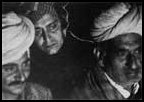


Like the way Rome was not built in a day, the empire of Bengali cinema took ages to come into existence. It passed through the silent era, the talkie era, the Independence era, the era of the late 60’s and lately the modern era.
In contrast to the Mumbai movie industry, the smaller number of movie makers in Calcutta make non-commercial gems that stand up to anything produced for sophisticated western audiences. The only Indian film director known outside Asia is a Bengali, Satyajit Ray, whose films have almost revolutionized the Indian movie industry. Satyajit Ray has tried to convey the idea of films as a form of art, which has been widely appreciated by the masses in India, mostly in Bengal. Ray’s passion, which is so evident in his famous trilogy Pather Panchali, Aparajito, and Apur
Sansar,for depicting the truth, plus his gift for capturing the quintessence of the Bengali character, has brought promise of a second Bengali renaissance-in the world of movies. There are a few other directors who are trying to follow in his footsteps, such as Rituparno Ghosh. His films,' Dahan' and 'Baariwaali' have been really liked and appreciated by people in India as well as in foreign countries.He is a very talented director and can really draw out the best performances from the actors and actresses in his films.
Bengali cinema had to fight against an unequal battle with Hindi cinema, which had far greater resources in all circumstances. Bengali cinema was thus going into a tremendous loss but was not swamped away because of two major things. One was the tremendous support of the Bengali middle class with its addiction to stories with incidents and emotions. The other thing that opposed the onrush of Hindi movies were the star phenomenon of all times, Uttam Kumar and Suchitra Sen. Bengali cinema was in a fumbling state of unsure direction until it found the potentialities of Uttam Kumar in 'Basu Parivar' (1952), and 'Sare Chuattar' (1953). Uttam Kumar and Suchitra proved to be an excellent and unparalleled pair in the cinematic world in 'Agni Pariksha' (1954).
There was a complete change in the trend of Bengali movie when Satyajit Ray made 'Pather Panchali' (1955), a novel written by a famous Bengali novelist Bibhuti Bhusan Banerjee. It became a milestone in the history of Bengali cinema. It ushered in a period of resurgence in Bengali cinema that restored its position of leadership of Indian Art cinema. 'Aparajito' (1957), 'Paras Pathar' (1957), 'Jalsaghar' (1959), were some of the other films made by Satyajit Ray, all of which turned out to be hits one after another.
The renaissance that had started in the early fifties had continued its essence for a long time, even in the seventies. This was proved by many directors, not once but by many a times. Ray continued making films, which added feathers to his laurel wreath. 'Pratidwandi' (1970), 'Seemabaddha' (1971) and 'Jana Aranya' (1971), were the trilogy on contemporary urban India. They probe and depict the unrest and the frustration of the educated unemployed youth, the amorality of the rich and their quest for pleasure, the erosion and corruption of values of a society caught up in the competitive fury of the modern world.
The young filmmakers appeared in the late seventies and eighties and have refurbished to some extent the fading image of Bengali cinema. One of them was Aparna Sen who directed the films '36 Chowringhee Lane' (1981), 'Paroma' (1983), 'Sati' (1989),etc. and in the nineties, it was Rituparno Ghosh, who directed movies like ‘Dahan’ and "Unishe April’ and strengthened the foundation of Bengali cinema.
